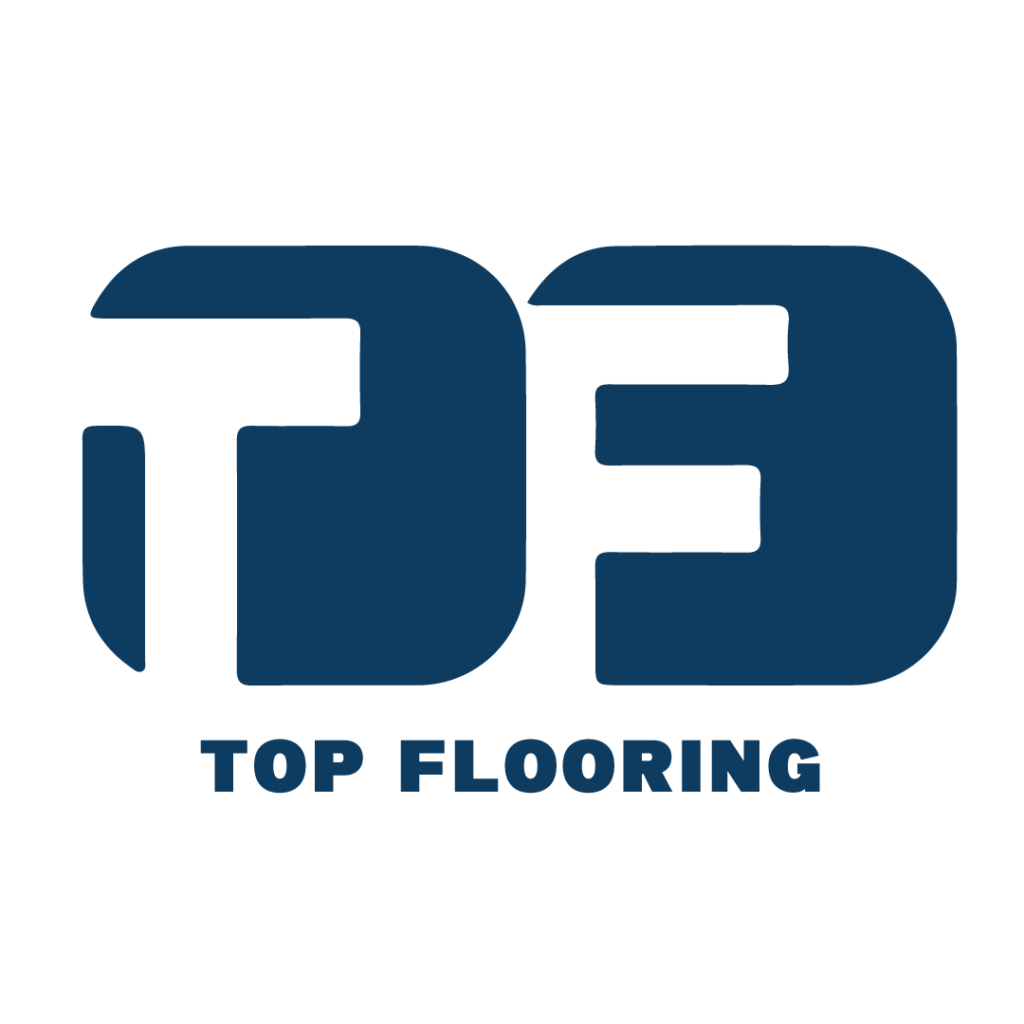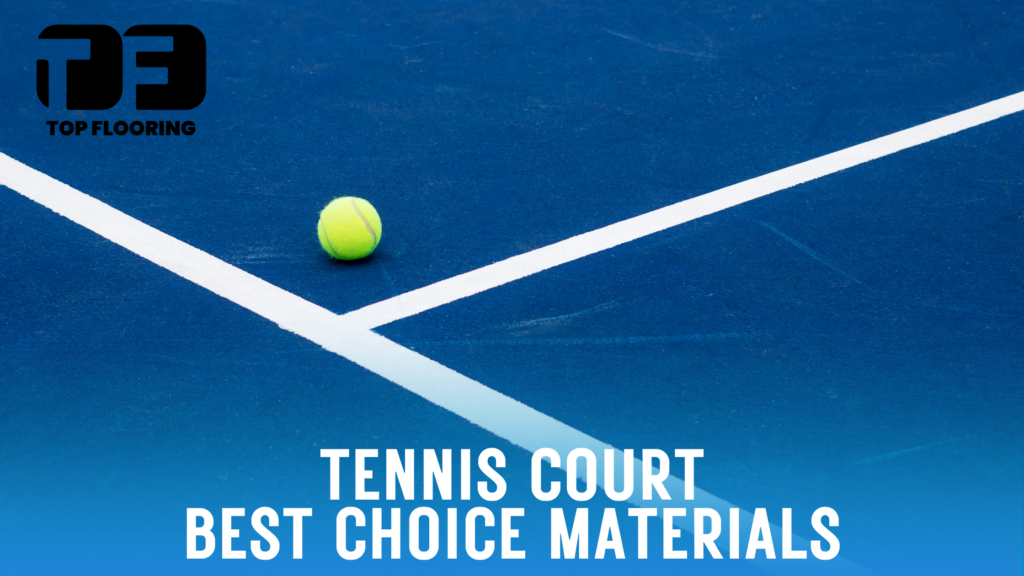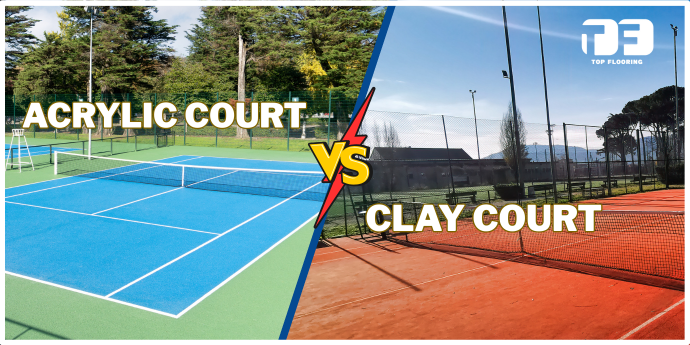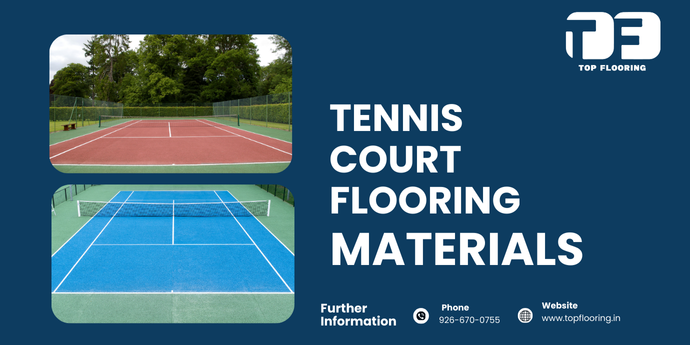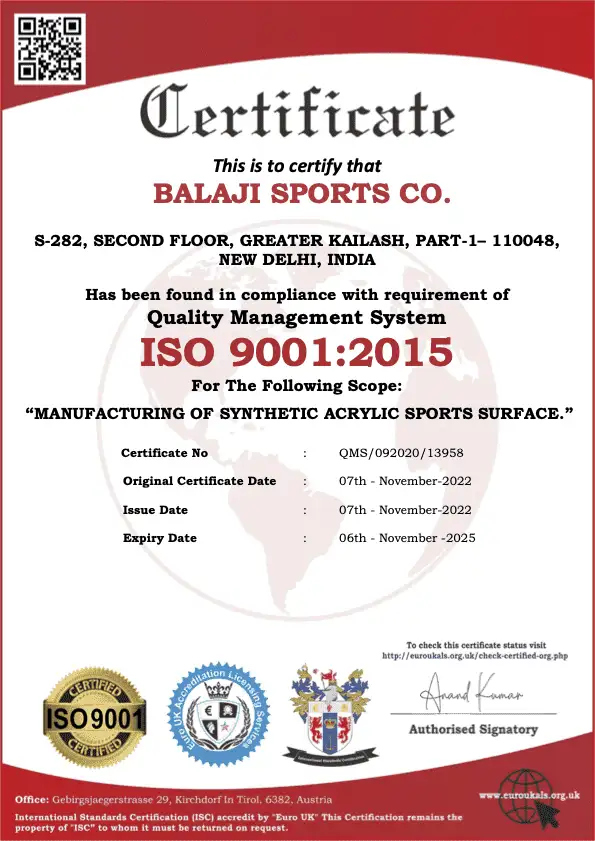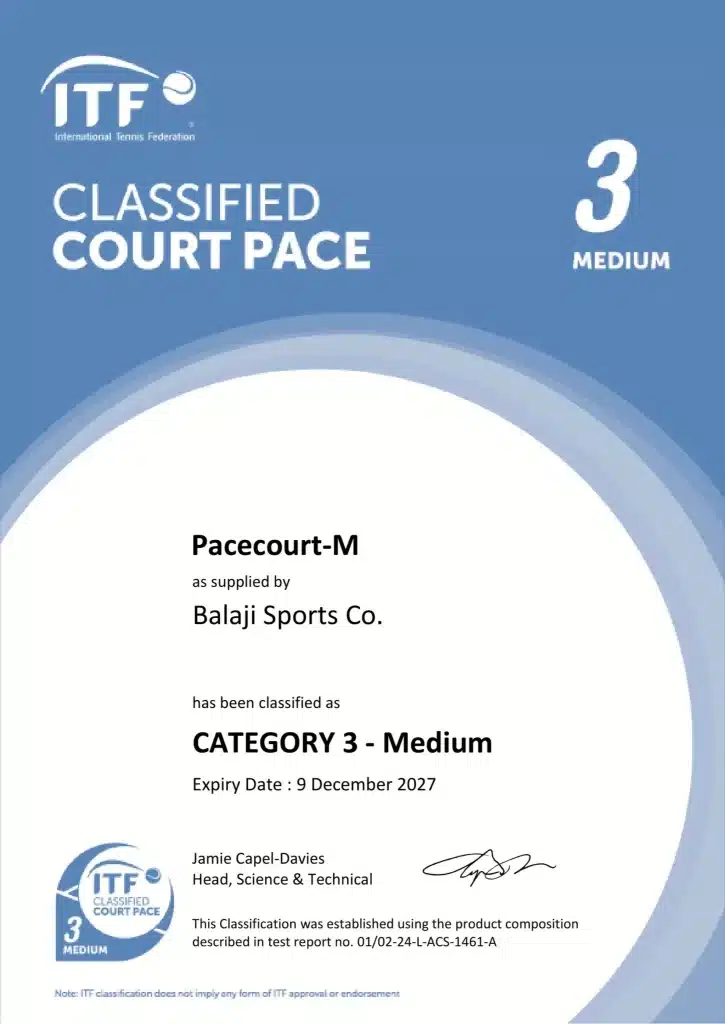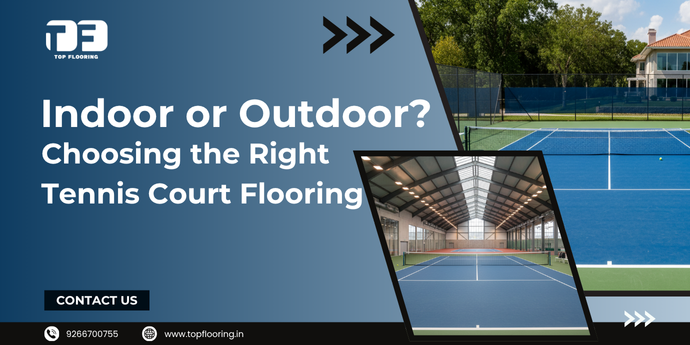
Tennis has always been called the “sport of a lifetime,” with players of all ages, from school kids to professionals at academies and even fitness enthusiasts in housing societies. In India, the demand for tennis court construction has gone up in recent years as more communities, institutions and clubs realize the importance of having world class sports facilities. But one of the biggest decisions in the entire process is deciding between indoor or outdoor tennis court flooring.
Why does this matter so much? Because flooring is the heart of every tennis court. It affects the speed of the game, the bounce of the ball and the safety of the players. The right tennis court flooring not only enhances performance but also longevity and reduces maintenance. And poor quality or wrong tennis court material can lead to cracks, fading and costly resurfacing.
In this blog we will explore the pros and cons of indoor and outdoor tennis court flooring, compare the costs, highlight the best tennis court surface materials, and show how experienced tennis court construction companies like Top Flooring can help you make the right choice. Whether you’re searching for “how much to build a tennis court” or looking for “tennis court resurfacing near me”, this guide will give you clear and practical answers.
Why Tennis Court Flooring Matters
Before we compare indoor and outdoor tennis court flooring setups, let’s understand why tennis court flooring is the most important part of any tennis court construction project. The flooring is not just the visible layer where the game is played, it’s the base of the entire court, which affects performance, safety, longevity and long term costs.
- Performance: The surface of a tennis court decides how the ball bounces, how fast the game is played and how players adjust their techniques. A good tennis court surface material ensures consistent bounce and grip, giving players confidence in every shot.
- Player Safety: A well designed court is not just about performance but also about the players. Slip resistance, cushioning layers and shock absorption are the key features of modern synthetic tennis court material.
- Durability: India’s climate from scorching summers to heavy monsoons puts a lot of stress on sports infrastructure. Courts exposed to UV rays, rain and humidity need flooring that can withstand these elements without cracking or fading.
- Maintenance Costs: Instead of spending frequently on repairs, facility owners just need to do tennis court resurfacing near me every 5-7 years. This not only saves long term costs but also ensures uninterrupted use of the court for players and members.
- Resale Value: For housing societies, schools and clubs, a professionally built tennis court is more than a recreational facility it’s an asset. Sports infrastructure directly adds to property value and community appeal.
Whether you are looking for tennis court construction companies for a school project or searching “tennis court resurfacing near me” for an existing facility, flooring is the deciding factor.
Indoor Tennis Court Flooring
Indoor courts are super popular in metros and premium academies where athletes train year-round. These facilities allow tennis court builders to build professional grade courts that match international standards, so players get the same experience as during tournaments.
Flooring Options for Indoor Courts
- Cushioned Acrylic Systems – These are the most recommended for professional training academies and clubs. A cushioned acrylic system consists of multiple layers – base coats, cushion coats and top acrylic color coats – all applied over a concrete or asphalt slab.
- Synthetic Flooring – Synthetic flooring solutions are versatile and multi-purpose, often used in facilities that host more than just tennis. These systems are durable, low maintenance and provide uniform traction, so suitable for indoor community halls, schools and recreational centers.
- Wooden Surfaces – Wooden courts offer a fast-paced playing experience with precise ball bounce but demand regular polishing and are not as resilient as synthetic or acrylic systems.
Benefits of Indoor Tennis Court Surface
- Weather Independence: The most obvious benefit of indoor courts is no cancellations. Matches or training sessions don’t get cancelled because of rain, extreme heat or strong winds.
- Consistent Play: Indoor conditions are controlled, so the bounce, grip and speed of the ball remains uniform every time.
- Longevity: Since indoor flooring is not exposed to UV radiation, heavy rainfall or dust, it has a longer lifespan than outdoor courts.
Limitations of Indoor Tennis Court
- High Construction Cost: Indoor courts require more than just flooring. Roofing, structural walls, ventilation, insulation and specialized lighting systems all add to the tennis court construction cost.
- Space Requirement: Indoor courts need large covered areas with high ceilings to accommodate lobs and long rallies. So not feasible in crowded urban areas or smaller housing societies where open land is limited.
Indoor tennis court flooring provides unmatched consistency, comfort and longevity but at a higher cost. For those who prioritize professional training environments and no cancellations, indoor courts are the way to go.
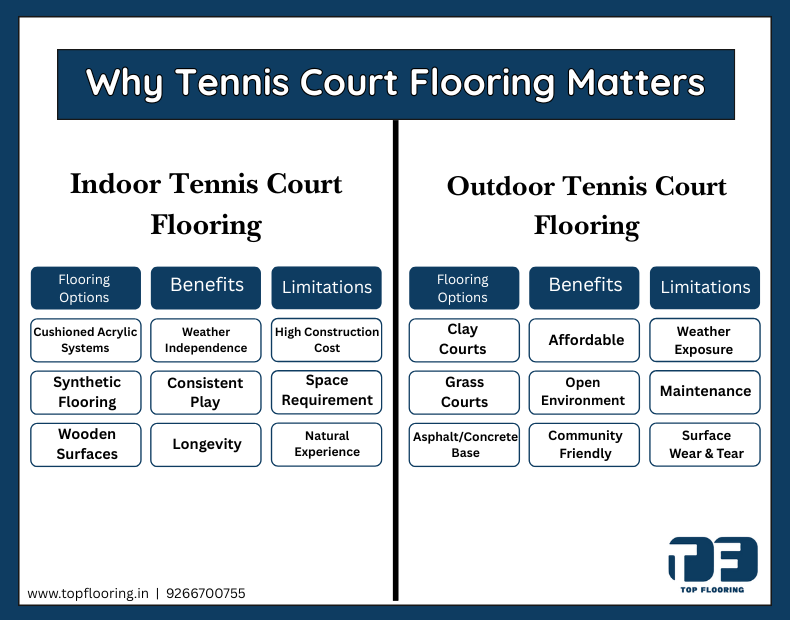
Outdoor Tennis Court Flooring
Outdoor tennis courts are the most common type of courts in India, found in schools and housing societies to training academies and large public sports complexes. They are cost-effective, adaptable and accessible.
Flooring Options for Outdoor Tennis Courts
- Synthetic Acrylic Courts – This is the most popular option today. Made from synthetic tennis court material, acrylic courts offer the perfect balance of affordability, durability and performance.
- Clay Courts – Clay courts are traditional and have a long history in the sport. While they offer slower gameplay and are good for endurance and strategy, they are high maintenance and not suitable for the Indian climate.
- Grass Courts – Grass courts are the premium end of tennis court flooring. Fast pace and luxurious feel, they are associated with prestigious tournaments like Wimbledon.
- Asphalt/Concrete Base – This is the standard construction method used by most tennis court builders in India. The base provides structural strength and acrylic coating systems add texture, cushioning and weather resistance.
Benefits of Outdoor Tennis Court Surface
- Affordable: Outdoor courts are much cheaper to build than indoor courts as there is no need for roofing or advanced ventilation systems.
- Open Environment: Playing outdoors in natural light and fresh air is more enjoyable, especially for recreational players and community members.
- Community-Friendly: Outdoor courts are ideal for housing societies, schools and academies where the objective is to promote social interaction, fitness and recreation.
Limitations of Outdoor Tennis Court
- Weather Exposure: Outdoor courts are exposed to Indian climate, monsoons, UV rays and high heat can affect the surface. Without high quality tennis court coating material and proper drainage system, cracks, fading and waterlogging can occur.
- Maintenance: Resurfacing is required every 5-7 years using professional tennis court repair materials like resurfacing coats, silica sand and crack fillers.
Despite the challenges of weather and maintenance, outdoor courts are still the most common in India. They are versatile, budget friendly and adaptable to any space, from small society plots to professional academies.
Key Differences Between Indoor & Outdoor Flooring
| Factor | Indoor Tennis Court Flooring | Outdoor Tennis Court Flooring |
| Durability | Protected, lasts longer | Requires UV & weather resistance |
| Cost | Higher (roofing + flooring) | Lower, varies by materials |
| Maintenance | Minimal | Needs resurfacing every 5–7 years |
| Player Experience | Consistent, controlled play | Natural, adaptive play |
| Best For | Academies, clubs, pros | Schools, societies, communities |
This comparison highlights that the choice depends on usage, budget, and long-term goals.
Cost of Indoor vs Outdoor Tennis Court Construction
One of the most common questions property developers, schools and housing societies ask is: “How much does it cost to build a tennis court?” The answer is not universal—it largely depends on whether you’re considering an indoor tennis court construction or an outdoor tennis court construction, as well as the type of tennis court material used.
Indoor Tennis Court Construction Cost
Indoor courts are designed to provide professional, all season play. But this comes with a higher investment.
- Roofing & Infrastructure: The biggest factor is the enclosed structure. Roofing, walls and insulation adds to the cost.
- Lighting & Ventilation: Indoor courts require a sports lighting system to simulate daylight and proper ventilation or air conditioning for player comfort.
- Flooring & Coating: A cushioned acrylic or synthetic tennis court surface material is recommended for consistent bounce and player safety. These surfaces are premium compared to basic outdoor coatings.
Depending on design, location and finishing an indoor tennis court cost can vary from mid range to very premium. While the tennis court construction cost is higher the advantage is minimal maintenance, longer flooring life and uninterrupted play throughout the year.
Outdoor Tennis Court Construction Cost
Outdoor courts are the most popular in India, especially for schools, housing societies, academies and clubs. They are more affordable and easier to construct compared to indoor courts.
- Base Preparation: Costs start with the tennis court ground material, usually concrete or asphalt. This is the base of the court.
- Synthetic Acrylic Surfacing: Among all options synthetic tennis court material with multi layer acrylic systems is the most cost effective and durable especially for Indian climate.
- Optional Additions: Fencing, outdoor lighting and seating can add to the cost but is optional based on project scope.
The overall cost of outdoor courts is much lower than indoor courts. But resurfacing every 5-7 years with quality tennis court repair materials is necessary to maintain performance.
Player Experience & Safety on Tennis Court
When it comes to tennis court flooring, player experience and safety are two of the top priorities. The type of court, indoor or outdoor directly impacts how the game feels. How safe it is for players and the kind of training environment it creates.
Indoor Tennis Court Surface
Indoor tennis courts are known for predictable bounce, uniform grip and faster play speeds. Since these courts are built in controlled environments, players don’t have to deal with distractions like wind, rain or harsh sunlight. This makes indoor flooring ideal for professional training academies where consistency and precision is required.
The smoother and more uniform nature of indoor tennis court surface material reduces the risk of slips or uneven bounce. It allows players to focus on technique, footwork and stamina without worrying about weather interruptions. Safety is further enhanced when indoor courts are built with synthetic tennis court material and cushioned acrylic layers which absorbs impact and reduces stress on joints.
Outdoor Tennis Court Surface
Outdoor tennis courts on the other hand bring players closer to natural playing conditions. Exposed to sun, wind, dust and rain, these courts offer a slightly tougher play environment compared to indoor ones. While the challenges are greater, they also build adaptability and resilience in players. For example outdoor matches require adjustments in timing, footwork and shot selection depending on weather conditions.
From a safety perspective outdoor courts must be built with UV resistant tennis court coating material and slip resistant textures to handle wet or dusty surfaces. Regular maintenance including tennis court resurfacing near me ensures that cracks or worn out areas are repaired before they cause injuries. For community level play in housing societies and schools outdoor courts are the perfect balance of affordability, accessibility and performance.
In the end while indoor courts offer professional consistency and outdoor courts provide real world adaptability. Both can deliver safe and enjoyable play when built with the right tennis court repair materials and coating systems.
Which One Should You Choose?
- Housing Societies & Schools → For residential communities and schools, outdoor synthetic tennis court flooring is the way to go. It’s cost effective, easy to install and requires less infrastructure than indoor courts. Housing societies get a recreational space that also adds to property value and schools can encourage students to play sports without big investments.
- Clubs & Academies → Professional training facilities, sports clubs and academies opt for indoor cushioned acrylic tennis courts. These courts are usable all year round, not affected by monsoons, scorching heat or strong winds.
- Multi-Purpose Facilities → When a facility is designed for multiple sports or community events, outdoor tennis courts with fencing, lighting and weather resistant systems are the best. These courts can be used not only for tennis but also for recreational events, fitness activities and other sports.
Ultimately, the choice between indoor and outdoor tennis court flooring boils down to three main factors: space, budget and target users. If affordability and community engagement is the goal, outdoor acrylic systems are the way to go.
Why Choose Top Flooring for Outdoor Tennis Courts?
When it comes to tennis court construction, the choice of flooring partner can make or break your project. A well built court isn’t just about looks, it’s about long term performance, safety and cost efficiency.
- Tennis Court Construction Expertise: With years of experience, Top Flooring has built numerous ITF standard courts for academies, schools, housing societies and clubs. Their team of professional tennis court builders understand the science behind flooring systems right from selecting the right tennis court surface material to ensuring proper slope, drainage and finishing.
- Certified Materials: Not all tennis court material is created equal. Top Flooring uses ISO certified and ITF approved synthetic tennis court material, for superior performance and safety.
- Custom Solutions: Every facility has unique requirements—whether it’s a housing society looking for a cost effective outdoor court, a professional academy demanding cushioned indoor flooring or a school with limited space.
- End to End Execution: Unlike smaller contractors who only provide partial services, Top Flooring manages the entire project lifecycle. From site preparation and concrete/asphalt base construction to fencing, lighting and painting, they ensure smooth execution.
- Resurfacing Support: Tennis courts need maintenance. Many facility owners often search for “tennis court resurfacing near me” when cracks, faded lines or surface wear appears.
- Pan India Presence: From Delhi NCR to Chennai and from housing societies to elite sports academies, Top Flooring has built a reputation for quality across India. Their wide presence ensures timely delivery of tennis court construction projects and easy access to support services across India.
By choosing Top Flooring, clients are not just getting a contractor they’re getting a long term partner. With certified tennis court coating materials, expert tennis court builders and dependable resurfacing services, Top Flooring delivers tennis courts built for durability, performance and long term value.
Conclusion
What remains constant is the importance of working with reliable tennis court construction companies who use certified synthetic tennis court materials and have experience. That’s where Top Flooring stands out. With years of experience, ITF approved systems and end to end solutions, they are more than just tennis court builders; they are long term partners who will make sure your court is safe, durable and professional for years to come.
So whether you are planning a professional academy with an indoor cushioned acrylic system or a housing society looking for outdoor tennis court ground material that can withstand Indian weather, the right choice starts with the right partner. If you are serious about tennis court construction don’t just search for “tennis court resurfacing near me” or compare “how much to build a tennis court” online. Reach out to experts who can give you clarity, transparency and certified quality. With Top Flooring your vision of a perfect tennis court outdoor can become a reality.
Frequently Asked Questions
Indoor courts are best for professional academies and year round play, while outdoor courts are good for schools, societies and budget friendly projects.
The tennis court cost depends on base preparation, materials and indoor vs outdoor setup. Outdoor acrylic courts are the most affordable.
Synthetic acrylic tennis court flooring is the most durable and widely used in India because of its weather resistance and low maintenance.
On an average outdoor courts need tennis court resurfacing near me every 5-7 years depending on usage and climate.
Yes, using tennis court repair materials such as resurfacing coats, crack fillers and new line markings old courts can be renewed cost effectively.
